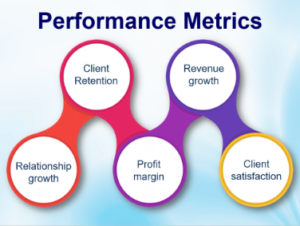
July 31, 2024
In the digital world,
success is about having the right business growth performance metrics

Do your company’s business performance metrics align with the way a digital enterprise delivers value?
In a recent McKinsey Global Survey of 2,190 companies, two thirds of those companies in pursuit of transforming their businesses into digital enterprises said that they were “just treading water, taking no decisive action, and consequently achieving little or no success.”
To be clear, making a fundamental change in a company’s business model is no easy task. It requires total alignment and commitment from the C-Suite and Board all the way down into the day-to-day operations of the organization.
Even though there is a growing body of evidence across multiple industries that transforming into a digital enterprise equates to sustainable competitive advantage, there are still many more laggards than leaders.
Based on my work over the past 10 years, I have seen first-hand how hard it is for a company to change the way it delivers its core value proposition as a digital enterprise.
Committing to a fundamental change in the way your company delivers value

To successfully execute a core value proposition pivot represents one of the greatest leadership challenges senior executives and their teams face today. Not only does this shift challenge long held beliefs about what has made a company successful but also calls into question what are the relevant skills, capabilities, and resources needed to compete as a digital enterprise.
Making a pivot of this breadth and scope requires a fundamental change in how a company delivers value to its customers, employees, supply chain partners, and other key stakeholders. It spans a portfolio of initiatives:
- Improve the productivity and efficiency of its cost centers & support functions
- Modernize its operating model to deliver more compelling customer experiences
- Increase its ability to develop and deliver new innovations that leverage digital technology
- Transform its business model to compete as a digital enterprise
As my brother Geoffrey Moore said in his book Escape Velocity, freeing your company’s future from the pull of its past will be the differentiating factor between success and failure in the age of digital disruption. At its essence, business model transformation is all about freeing your company’s future from the pull of its past.
Some core questions to build alignment and commitment to changing the way your company measures its business growth performance
A successful business transformation initiative must start with the CEO, C-Suite, and Board all agreeing on what the ultimate outcome needs to be. There is no room for false starts and weak leadership resolve.
Here are some core questions I’ve found extremely helpful in getting the dialogue started and assessing the commitment needed to achieve a successful outcome:
1. How long can the company’s current business model deliver its desired business growth goals and financial results?
a. How sustainable are the company’s revenues, margins, and profits?
2. How vulnerable is the company’s business model to being digitally disrupted?
a. How quickly could the company respond to this digital disruption?
3. How well can the company leverage digital technology for increased competitive advantage?
a. How robust is the company’s digital technology pipeline?
4. How open is the company’s culture to changing the way it does business?
a. How capable is the company at competing as a digital enterprise?
New performance metrics that measure the new ways your company creates value

The starting point for creating the new metrics that matter for your company is to ask some clarifying questions:
- What performance metrics are most critical to how our company creates value?
- Do our existing metrics capture this value creation?
- What new metrics would better incent the behaviors and actions needed to create value as a digital enterprise?
- What metrics are our key digital competitors using to measure their performance?
Using the 4 Zones Model to align value creation outcomes with the right metrics
As the old adage says, what gets measured gets done. So, if you are measuring the wrong things then the wrong things are getting done. Less than 30% of companies have a process in place to measure the return on investment of their digital technology projects. As such, this lack of new measurement tools puts them at a significant competitive disadvantage as they try to pivot to be a digital enterprise.
KPI’s, OKR’s, ROI’s, NPS’s are just a few of the traditional acronyms for measuring different performance goals a company aspires to achieve. The challenge, however, is to be able to segment performance metrics based on the different ways a company creates value for its customers, employees, supply chain partners, and other key stakeholders.
With that thought in mind, we have developed a 4 Zone metrics framework that calls out specific measurement tools for each zone as shown on the chart below. It will also help you avoid the common mistake of using the wrong metrics to measure the different ways your company creates and delivers value.

Productivity Zone: Process Metrics

The primary role of the functions in the productivity zone including Finance, IT, HR, Marketing, Customer Service, Legal, Procurement, Compliance, and others is to enable the company’s operating businesses in the performance zone to meet or exceed their revenue, margin, and net profit goals. As such, they need to deploy a series of process improvement metrics that measure their ability to recover resources and budget trapped in low value creation functions and redeploy them to higher value functions.
A big mistake companies make in this zone is to equate cost reductions with value creation. The true measure of performance in this zone is how these support functions can leverage digital technology to directly impact and contribute to increasing revenues, margins, and profits. Ultimately functions like IT, Marketing, and Customer Service should be measured as profit centers not cost centers.
Performance Zone: Investor Metrics

Investors in public or private companies reward performance that drives sustainable value creation. The metrics that measure that performance are agreed upon during the annual planning process and often don’t reflect the increasing impact digital technologies will have on the performance of the company’s business units.
Much of the value creation in this zone comes from utilizing new systems of engagement and systems of intelligence to deliver exceptional customer experiences. Depending on whether you are a B2B or B2C business, you will need to adapt new metrics that measure how well you are engaging customers using these new systems and tools.
Incubation Zone: Venture Metrics

The biggest mistake most companies make in this zone is to use traditional performance zone metrics (e.g. EBITDA) to measure new innovation initiatives. Success in this zone comes from being able to efficiently identify, test, and validate multiple next generation products, services, and ideas. The key performance measures should be speed to market and time to value.
The reason many early stage, venture backed companies disrupt well established companies is because they outperform them in this zone. They are much better at failing fast and redeploying what they’ve learned to the next innovation opportunity. As such, the metrics they use incent that type of behavior.
The other big mistake in this zone is trying to scale multiple transformation zone initiatives at the same time. As I’ve said before, reallocating existing resources and budget from current businesses in the performance zone to create a net new business that can scale to 10% of the company’s current revenues is a very disruptive exercise for any organization. Trying to do more than one is a recipe for failure.
Transformation Zone: Hypergrowth Metrics

Value creation in this zone comes from adopting and deploying digital technologies to do two things:
- Launch and scale a material net new line of business
- Defend the company from an existential threat
In the first case, the key metrics to measure performance should include:
- The new business will scale to generate a 10% or greater increase in current revenues and profits for the company
- There can only be one transformation initiative done at a time
- 50% of the discretionary compensation of all critical stakeholders is solely based on the success of this effort
In the second case, the key metrics to measure performance should include:
- A commitment to invest in a J Curve to get to an S Curve knowing returns may take 24 months
- A compelling business case for investors that will support investing in the J Curve
To excel at value creation as a digital enterprise requires a company to undertake a fundamental change in its business model and how that model serves the changing interests of its customers, employees, and other key stakeholders. As such, there must also be a fundamental change in the metrics that incent and measure that shift.
There must be complete alignment and commitment from the C-Suite, Board, down into the front-line workers to ensure the success of this transformative journey. Once started, there can be no turning back and no loss of resolve to achieve the desired outcomes.
|




